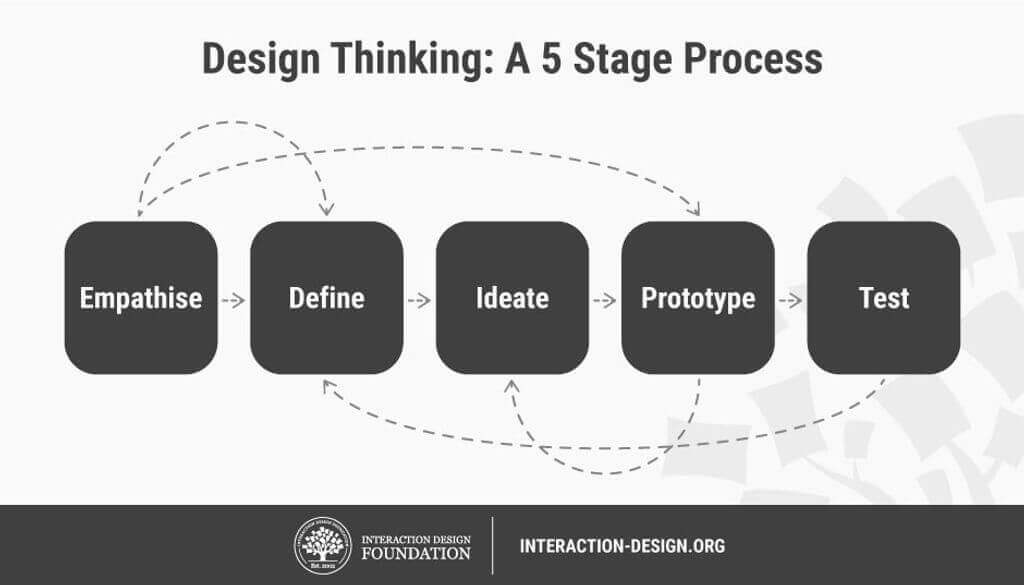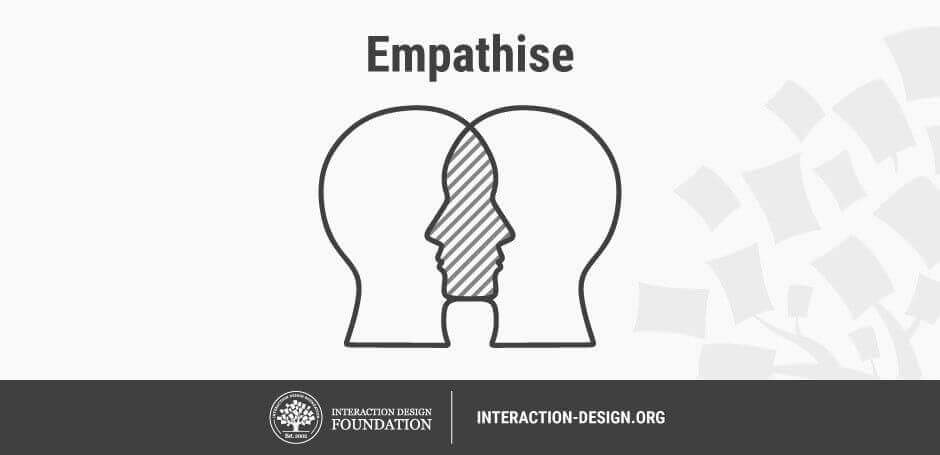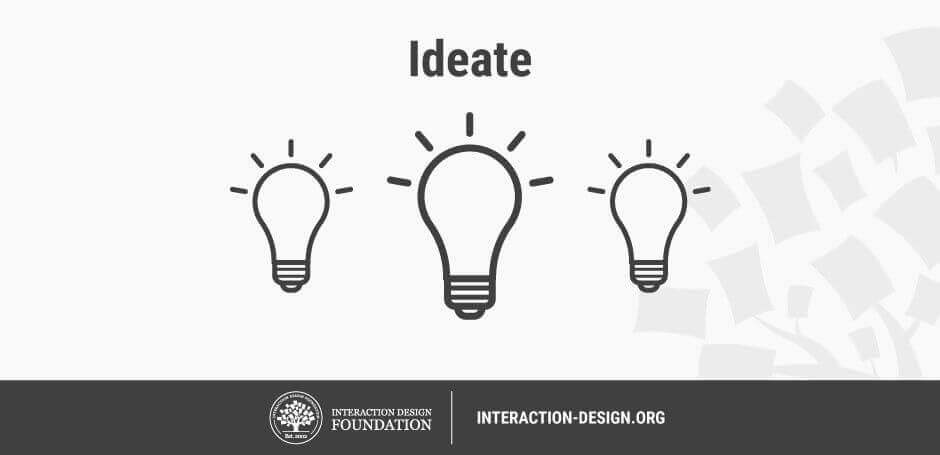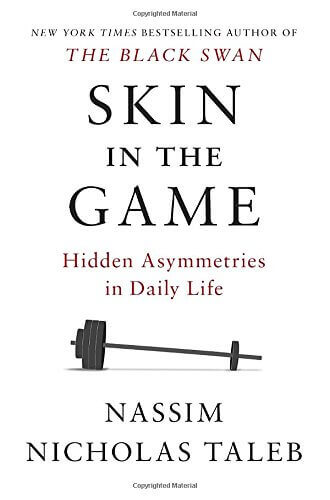
5 Stages in the Design Thinking Process
Design Thinking is a design methodology that provides a solution-based approach to solving problems. It’s extremely useful in tackling complex problems that are ill-defined or unknown, by understanding the human needs involved, by re-framing the problem in human-centric ways, by creating many ideas in brainstorming sessions, & by adopting a hands-on approach in prototyping & testing.
Understanding these five stages of Design Thinking will empower anyone to apply the Design Thinking methods in order to solve complex problems that occur around us ~ in our companies, in our countries, & even on the scale of our planet.
We will focus on the five-stage Design Thinking model proposed by the Hasso-Plattner Institute of Design at Stanford (d.school). d.school is the leading university when it comes to teaching Design Thinking. The five stages of Design Thinking, according to d.school, are as follows: Empathise, Define (the problem), Ideate, Prototype, & Test. Let’s take a closer look at the five different stages of Design Thinking.
I. Empathise

The first stage of the Design Thinking process is to gain an empathic understanding of the problem you are trying to solve. This involves consulting experts to find out more about the area of concern through observing, engaging & empathizing with people to understand their experiences and motivations, as well as immersing yourself in the physical environment so you can gain a deeper personal understanding of the issues involved. Empathy is crucial to a human-centered design process such as Design Thinking, & empathy allows design thinkers to set aside their own assumptions about the world in order to gain insight into users and their needs.
Depending on time constraints, a substantial amount of information is gathered at this stage to use during the next stage & to develop the best possible understanding of the users, their needs, & the problems that underlie the development of that particular product.
II. Define (the Problem)
.jpg)
During the Define stage, you put together the information you have created & gathered during the Empathise stage. This is where you will analyse your observations & synthesise them in order to define the core problems that you & your team have identified up to this point. You should seek to define the problem as a problem statement in a human-centred manner.
To illustrate, instead of defining the problem as your own wish or a need of the company such as, “We need to increase our food-product market share among young teenage girls by 5%,” a much better way to define the problem would be, “Teenage girls need to eat nutritious food in order to thrive, be healthy & grow.”
The Define stage will help the designers in your team gather great ideas to establish features, functions, & any other elements that will allow them to solve the problems or, at the very least, allow users to resolve issues themselves with the minimum of difficulty. In the Define stage you will start to progress to the third stage, Ideate, by asking questions which can help you look for ideas for solutions by asking: “How might we… encourage teenage girls to perform an action that benefits them & also involves your company’s food-product or service?”
III. Ideate

During the third stage of the Design Thinking process, designers are ready to start generating ideas. You’ve grown to understand your users & their needs in the Empathise stage, & you’ve analysed & synthesised your observations in the Define stage, & ended up with a human-centered problem statement. With this solid background, you & your team members can start to "think outside the box" to identify new solutions to the problem statement you’ve created, & you can start to look for alternative ways of viewing the problem. There are hundreds of Ideation techniques such as Brainstorm, Brainwrite, Worst Possible Idea, & SCAMPER. Brainstorm & Worst Possible Idea sessions are typically used to stimulate free thinking & to expand the problem space. It is important to get as many ideas or problem solutions as possible at the beginning of the Ideation phase. You should pick some other Ideation techniques by the end of the Ideation phase to help you investigate & test your ideas so you can find the best way to either solve a problem or provide the elements required to circumvent it.
IV. Prototype

The design team will now produce a number of inexpensive, scaled down versions of the product or specific features found within the product, so they can investigate the problem solutions generated in the previous stage. Prototypes may be shared & tested within the team itself, in other departments, or on a small group of people outside the design team. This is an experimental phase, & the aim is to identify the best possible solution for each of the problems identified during the first three stages. The solutions are implemented within the prototypes, &, one by one, they are investigated & either accepted, improved & re-examined, or rejected on the basis of the users’ experiences. By the end of this stage, the design team will have a better idea of the constraints inherent to the product & the problems that are present, & have a clearer view of how real users would behave, think, & feel when interacting with the end product.
V. Test

Designers or evaluators rigorously test the complete product using the best solutions identified during the prototyping phase. This is the final stage of the 5 stage-model, but in an iterative process, the results generated during the testing phase are often used to redefine one or more problems & inform the understanding of the users, the conditions of use, how people think, behave, & feel, & to empathise. Even during this phase, alterations & refinements are made in order to rule out problem solutions & derive as deep an understanding of the product & its users as possible.
The Non-Linear Nature of Design Thinking
We may have outlined a direct & linear Design Thinking process in which one stage seemingly leads to the next with a logical conclusion at user testing. However, in practice, the process is carried out in a more flexible & non-linear fashion. For example, different groups within the design team may conduct more than one stage concurrently, or the designers may collect information & prototype during the entire project so as to enable them to bring their ideas to life & visualise the problem solutions. Also, results from the testing phase may reveal some insights about users, which in turn may lead to another brainstorming session (Ideate) or the development of new prototypes (Prototype).

It is important to note that the five stages are not always sequential ~ they do not have to follow any specific order & they can often occur in parallel & be repeated iteratively. As such, the stages should be understood as different modes that contribute to a project, rather than sequential steps. However, the amazing thing about the five-stage Design Thinking model is that it systematises & identifies the 5 stages/modes you would expect to carry out in a design project ~ & in any innovative problem-solving project. Every project will involve activities specific to the product under development, but the central idea behind each stage remains the same.
Design Thinking should not be seen as a concrete & inflexible approach to design; the component stages identified in the illustration above serve as a guide to the activities that you would typically carry out. In order to gain the purest & most informative insights for your particular project, these stages might be switched, conducted concurrently & repeated several times in order to expand the solution space, & zero in on the best possible solutions.
As you will note from the illustration above, one of the main benefits of the five-stage model is the way in which knowledge acquired at the later stages can feedback to earlier stages. Information is continually used both to inform the understanding of the problem & solution spaces, & to redefine the problem(s). This creates a perpetual loop, in which the designers continue to gain new insights, develop new ways of viewing the product & its possible uses, & develop a far more profound understanding of the users & the problems they face.
The Origin of the 5-Stage Model
In his 1969 seminal text on design methods, “The Sciences of the Artificial,” Nobel Prize laureate Herbert Simon outlined one of the first formal models of the Design Thinking process. Simon's model consists of seven major stages, each with component stages & activities, & was largely influential in shaping some of the most widely used Design Thinking process models today. There are many variants of the Design Thinking process in use in the 21st century, & while they may have different numbers of stages ranging from three to seven, they are all based upon the same principles featured in Simon’s 1969 model. We focus on the five-stage Design Thinking model proposed by the Hasso-Plattner Institute of Design at Stanford (d.school).
In essence, the Design Thinking process is iterative, flexible & focused on collaboration between designers & users, with an emphasis on bringing ideas to life based on how real users think, feel & behave.
“Which brings us to the principle:
If your private life conflicts with your intellectual opinion, it cancels your intellectual ideas, not your private life.
& a solution to the vapid universalism we discussed in the Prologue:
If your private actions do not generalize, then you cannot have general ideas.
This is not strictly about ethics, but information. If a car salesman tries to sell you a Detroit car while driving a Honda, he is signaling that the wares he is touting may have a problem.” ~ Curated Excerpt From: Nassim Nicholas Taleb. “Skin in the Game.” Apple Books.
Curated via Interaction Design Foundation. Thanks for reading, cheers! (with a glass of wine & book of course)

2018 Bougetz Cellars Parched Napa Cabernet Sauvignon
Producer: Bougetz Cellars, Napa Valley, Napa County, North Coast, California, USA
"Including 10% Merlot and a splash of Petit Verdot and Malbec, the 2018 Cabernet Sauvignon Parched has a classic Cabernet nose of dark currants and a touch of blue fruits as well as notes of cedar pencil, tobacco, and earth. Reminding me of a solid Pauillac, it's medium-bodied, has fine, polished yet present tannins, a good spine of acidity, and a great finish. It's well worth seeking out and should keep for 10-12 years, if not longer." ~ 91 Points ~ Jeb Dunnuck

Skin in the Game: Hidden Asymmetries in Daily Life
From the New York Times bestselling author of The Black Swan, a bold new work that challenges many of our long-held beliefs about risk and reward, politics and religion, finance and personal responsibility. In his most provocative and practical book yet, one of the foremost thinkers of our time redefines what it means to understand the world, succeed in a profession, contribute to a fair and just society, detect nonsense, and influence others. Citing examples ranging from Hammurabi to Seneca, Antaeus the Giant to Donald Trump, Nassim Nicholas Taleb shows how the willingness to accept one’s own risks is an essential attribute of heroes, saints, and flourishing people in all walks of life.
As always both accessible and iconoclastic, Taleb challenges long-held beliefs about the values of those who spearhead military interventions, make financial investments, and propagate religious faiths. The phrase “skin in the game” is one we have often heard but rarely stopped to truly dissect. It is the backbone of risk management, but it’s also an astonishingly rich worldview that, as Taleb shows in this book, applies to all aspects of our lives. As Taleb says, “The symmetry of skin in the game is a simple rule that’s necessary for fairness and justice, and the ultimate BS-buster,” and “Never trust anyone who doesn’t have skin in the game. Without it, fools and crooks will benefit, and their mistakes will never come back to haunt them.”

